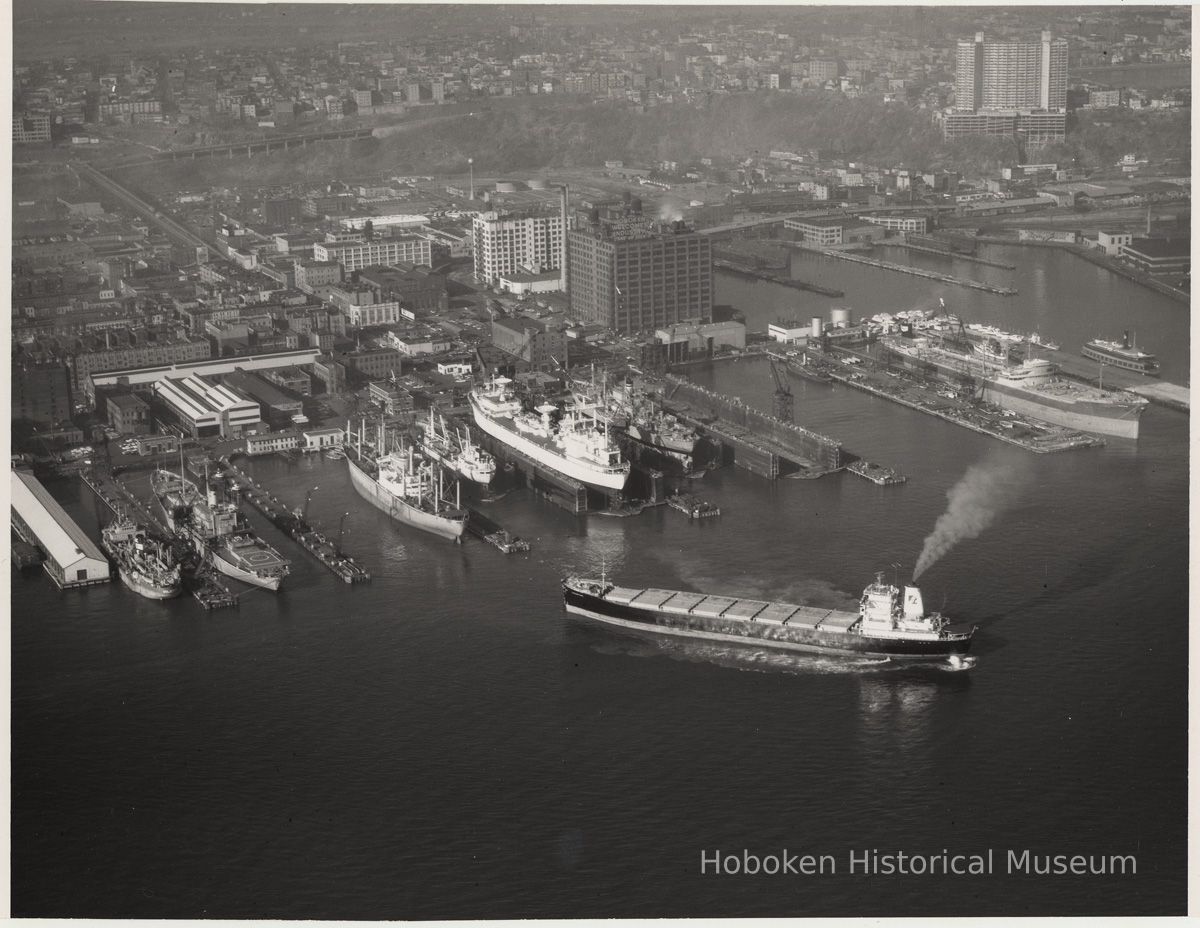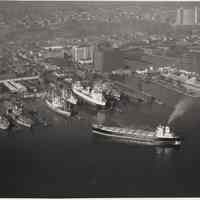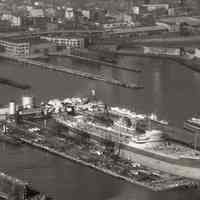Collections Item Detail
B+W aerial photo of S.S. Houston, Seatrain Lines, approaching dock; USS Compass Island, USNS Vanguard & other ships at Bethlehem Steel Hoboken Shipyard, n.d., ca. 1969.
2012.007.0065
2012.007
Lukacs, Claire
Gift
Museum Collections. Gift of a Friend of the Museum.
1969
Hoboken
8 in
10 in
Notes: Some historical background on two ships seen in the photo - USNS Vanguard followed by the U.S.S. Compass Island History of the Vanguard as found 2012: http://www.navsource.org/archives/home.html ; this specific link www.navsource.org/archives/09/53/5319.htm+&cd=2&hl=en&ct=clnk&gl=us USNS Vanguard (T-AG-194) ex USNS Vanguard (T-AGM-19) (1966 - 1999) USNS Mussel Shoals (T-AGM-19) (1964 - 1966) USNS Mission San Fernando (T-AO-122) (1949 - 1964) Mission San Fernando (AO-122) (1947 - 1949) Laid down, 26 August 1943, as a Maritime Commission type (T2-SE-A2) tanker hull, under Maritime Commission contract, (MC 1274), at Marinship Corp., Sausalito, CA. Launched, 25 November 1943 Delivered to the Naval Transportation Service, 29 February 1944 for charter by Pacific Tankers, Inc. for operation Returned to the Maritime Commission, 10 May 1946, for lay up in the National Defense Reserve Fleet Olympia, WA. Acquired by the Navy, 21 October 1947, for charter to Union Oil Co. and placed in service under the operational control of the Naval Transportation Service (NTS) as Mission San Fernando (AO-122) Transferred to the operational control the Military Sea Transportation Service (MSTS), 1 October 1949 and placed in service as USNS Mission San Fernando (T-AO-122) Placed out of service, 24 May 1955 Returned to the Maritime Administration for lay up in the National Defense Reserve Fleet, Olympia, WA. Struck from the Naval Register, 22 June 1955 Reacquired by the Navy, 21 June 1956, and placed in service with MSTS, operated under charter to Marine Transportation Lines. Placed out of service, 4 September 1957 Returned to the Maritime Administration for lay up in the National Defense Reserve Fleet, James River, Fort Eustis, VA. Reacquired by the Navy, 28 September 1964 Converted to a Missile Range Instrumentation Ship (AGM) at General Dynamics Corp., Quincy, MA. Renamed and reclassified USNS Mussel Shoals (T-AGM-19) while undergoing conversion Renamed Vanguard, 1 September 1965 Placed in service with MSTS as USNS Vanguard (T-AGM-19), 28 February 1966 Reclassified Miscellaneous Auxiliary (Navigational Test Launch Ship) (T-AG-194) in September 1980 Placed out of service, date unknown Struck from the Naval Register 13 December 1999 Custody transferred to MARAD for lay up in the National Defense Reserve Fleet, James River, Fort Eustis, VA. Final Disposition, fate unknown [end Navy history] ----------- As tracking and navigational test ship, 1964–1999 Vanguard selected text from Wikipedia, the free encyclopedia: http://en.wikipedia.org/wiki/USNS_Mission_San_Fernando_(T-AO-122) U.S.N.S. Vanguard (T-AGM-19) seen here as a NASA Skylab tracking ship. Note the SatCom tracking radar and telemetry antennas.Reacquired by the Navy on 28 September 1964 she was taken in hand by General Dynamics Quincy Shipbuilding Division for extensive modernization and rebuilding at its Quincy, Massachusetts yard. This included adding 80 feet to her length. While under conversion to a missile-range instrumentation ship, she was renamed for Muscle Shoals, Alabama and reclassified, becoming Muscle Shoals (AGM-19). Renamed Vanguard on 1 September 1965, she was placed in service with MSTS on 28 February 1966 as USNS Vanguard (T-AGM-19). Designed to be a seagoing missile tracking station, she participated in the Apollo Project test series and into 1969 had continued in these duties. She then participated in the Skylab program. In September 1980, she was reconfigured and the large missile tracking antennas were removed. She replaced the USS Compass Island and reclassified as T-AG-194. Her role became that of a Navigational Test Ship and she was used to check submarine navigation systems. She steamed over 250,000 miles in support of Poseidon and Trident I navigation subsystems and in development of the Trident II navigation subsystem. She was stricken again on 12 December 1999 after being replaced by USNS Waters (T-AGS-45).[1] [end Vanguard history] ------------- USS Compass Island (AG-153) From Wikipedia, the free encyclopedia Career (USA) Name: USS Compass Island (AG-153) Namesake: An island in Penobscot Bay off the coast of Maine Builder: New York Shipbuilding Corporation Launched: 24 October 1953 as Garden Mariner Acquired: 29 March 1956 Commissioned: 3 December 1956 Decommissioned: 1 May 1980 Struck: 31 March 1986 Fate: Maritime Administration 9 April 1993 Status: National Defense Reserve Fleet General characteristics Class and type: Compass Island Displacement: 18,000 tons (full) Length: 563 ft (172 m) Beam: 76 ft (23 m) Draft: 26 ft (7.9 m) Speed: 20 knots Complement: 214 Compass Island (EAG-153) was launched 24 October 1953 as Garden Mariner by the New York Shipbuilding Corporation, Camden, New Jersey and sponsored by Mrs. H. A. Smith. Acquired by the Navy 29 March 1956 and commissioned 3 December 1956, Commander J. A. Dare in command. The first mission of Compass Island was to assist in the development and evaluation of a navigation system independent of shore-based and celestial aids, a necessary adjunct of the ballistic missile program. She operated along the eastern seaboard testing equipment and training personnel until 13 March 1958 when she sailed from New York for experiments in the Mediterranean, returning to New York 17 April to resume her east coast operations. A dramatic example of her work was provided when Nautilus (SSN-571), using the Shipboard Inertial Navigation System (SINS) first tested by Compass Island in 1957, made a submerged cruise beneath the Arctic ice pack touching exactly at the North Pole 3 August 1958. The INS hardware was the N6A-1 built by North American Aviation, a naval modification of the N6A designed for the Navaho cruise missile, and had also been installed on the Skate along with the Nautilus following successful sea trials on the Compass Island[1] (The USS Skate reached the North Pole the week after Nautilus, and in the following year became the first vessel to surface at the North Pole.) North Pole navigation succeeded after initial INS testing on the Compass Island.On 10 September 1958, Compass Island entered New York Naval Shipyard for overhaul and installation of additional navigational equipment to be tested. With this new equipment, she continued her east coast and Caribbean cruising through 1960. In 2003, Compass Island and three other decommissioned US Navy ships, the Caloosahatchee, Canopus and Canisteo, were towed to the port city of Hartlepool in the United Kingdom to be scrapped, but UK environmentalists protested their arrival at Able UK, the salvage company. Work to dismantle a controversial fleet of former US warships was slated to begin in the summer of 2008, five years after the company originally won the scrapping contract. Original or Copy: Original Status: OK Status By: West, D. Status Date: 2012-03-23






